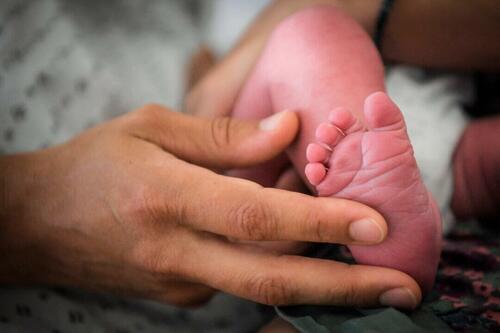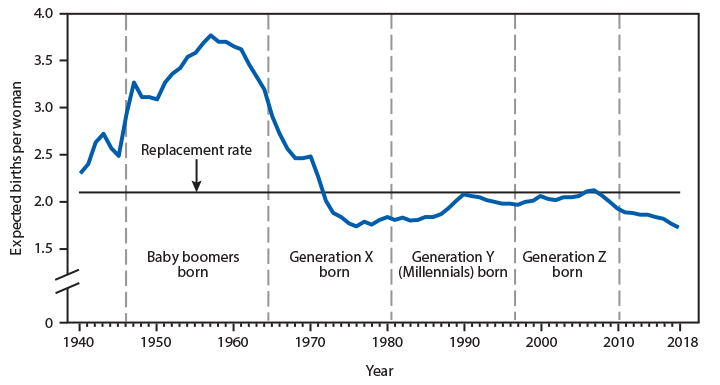
Posted on 07/24/2025 8:05:35 PM PDT by SeekAndFind
The number of births in America in 2024 increased from 2023, but the fertility rate declined, the Centers for Disease Control and Prevention said on July 24.
Births rose 1 percent from 2023 to 2024, the CDC said in a brief. The number of births in 2024 was 3.62 million.
That’s down from 3.9 million in 2010 and 16 percent lower than the peak of 4.3 million in 2007. It’s about the same as most recent years, although just 3.59 million were logged in 2023.
The fertility rate among females aged 15 to 44, on the other hand, declined by 1 percent in 2024 to 53.8 births per 1,000.
That’s down from 64.7 births per 1,000 females in that age group in 2010 and 118 per 1,000 females in the population in 1960.
The new fertility rate is the lowest on record, sinking from the previous low of 54.5 births per 1,000 females aged 15 to 44 in 2023.
It equals less than 1.6 children per female of childbearing age. Worldwide, the fertility rate is 2.2 children per female, according to the World Bank.
The birth and fertility data are drawn in part from birth certificates and U.S. Census data.
President Donald Trump, his administration, and members of Congress have said the falling fertility rate is a cause for concern.
A recent bill approved by Congress and signed by the president includes $1,000 accounts for newborns.
Trump in February also signed an order aimed at making in vitro fertilization, a method of conception, more affordable.
Birth rates are generally declining for women in most age groups—and that doesn’t seem likely to change in the near future, said Karen Guzzo, director of the Carolina Population Center at the University of North Carolina.
People are marrying later and are also worried about their ability to have the money, health insurance, and other resources needed to raise children in a stable environment, said Guzzo, who described measures such as the newborn accounts as largely symbolic.
Women in the United States have been giving birth on average at older ages. In 2024, the birth rate for females aged 15 to 34 declined. The rate was the same among women aged 35 to 39, and went up for women aged 40 to 44, according to the CDC.
That was a change from provisional data released earlier in the year that had indicated birth rate increases for women in their late 20s and 30s.
CDC officials said it was due to recalculations stemming from a change in the Census population estimates used to compute the birth rate.
It would be enlightening to see a line graph chart showing bothlive birth rate and abortion rate.
Good. Its already the 3rd most populated country. Enough.
Everything is fine.
Robots & AI will solve this “future of civilization’ problem.(sarcasm)
Huh? Whatch you talking about Jethro?

Huh? Whatch you talking about Jethro?
***”***”******
He probably wants some “elbow room.”
Over the next 20 years he’ll have plenty of it in North America, Europe, and Asia.
They forgot this part: “among US citizens “.
Did you read the article? Low birthrate. Sounds good. And my name is not Jethro cletus.
Break it down by religious and political beliefs and citizenship status. That will be a much more interesting chart.
Come on, young people, get busy! I did my part, now it’s your turn.
Only Mormons and Muslims are having children.
As I noted in another thread, but forgot to credit.
The percentage of births covered by Medicaid declined for each maternal age group from 2023 to 2024.
● Medicaid was the primary source of payment for the delivery for 40.2% of all births in 2024, a decline of 3% from 2023 (41.5%) (Figure 4, Table 4).
● The percentage of births covered by Medicaid declined 2%–3% for all age categories:
younger than age 20 (from 78.5% to 77.1%),
20–24 (63.3% to 61.5%),
25–29 (44.1% to 42.9%),
30–34 (30.8% to 30.0%),
35–39 (28.1% to 27.3%), and
40–44 (30.8% to 30.0%)
Nothing to see here. But for Medicaid, there probably would be 40% less birth in the US.
NCHS Data Brief ■ No. 535 ■ July 2025
Births in the United States, 2024
Joyce A. Martin, M.P.H., Brady E. Hamilton, Ph.D., and Michelle J.K. Osterman, M.H.S.
https://www.cdc.gov/nchs/data/databriefs/db535.pdf
Last year in my family we had a summer of weddings to attend. This summer, all of those weddings are producing babies by the years’s end. One was born this week, another is due next week, and a third is due in December. Plus, there’s another baby on the way from a wedding two summers ago around Thanksgiving. So all is not lost. At least in my world.
11 grandkids and counting. I’M DOING MY PART
Low birthrate is the death of a country.
The cost of living is too high. If having a family and children was as affordable as it was in 1970 the birth rate would be at least at replacement levels in my opinion. Everything is stacked against family formation. Rents are higher than ever. Wages for unskilled jobs are lower than ever. A bachelor degree isn’t even enough for many graduates. And then there is a myriad of small things to hassle young parents. 8 years ago I had a son that was in the NICU because he was a preemie. In order to take him home I needed a new/newer infant car seat. If I was 20 and just starting out something as simple as that would have been a luxury purchase and I would have wanted to get something as close to free as possible just to comply with the law. We have stacked the deck in large and small ways to make raising children more expensive. And to top it all off, at any point in time either the husband or wife could tell the other they want a divorce. So raising a family is out of reach for the very young. The risks to being financially and emotionally devastated are extremely high. And if you toss in hookup culture where men can get their physical needs met outside of marriage, I am amazed the birth rate is as high as it is right now.
“Only Mormons and Muslims are having children.”
You forgot the illegals.
wy69
Well, stuff has consequences.
Disclaimer: Opinions posted on Free Republic are those of the individual posters and do not necessarily represent the opinion of Free Republic or its management. All materials posted herein are protected by copyright law and the exemption for fair use of copyrighted works.